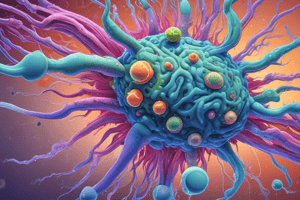Podcast
Questions and Answers
What are the two main components of peptidoglycan?
What are the two main components of peptidoglycan?
- N-acetylcysteine and N-acetylglycine
- N-acetylserine and N-acetylproline
- N-acetylglucosamine (NAG) and N-acetylmuramic acid (NAM) (correct)
- N-acetylalanine and N-acetylmethionine
Eukaryotes contain peptidoglycan in their cell walls.
Eukaryotes contain peptidoglycan in their cell walls.
False (B)
What type of bond links the amino acids within the peptidoglycan structure?
What type of bond links the amino acids within the peptidoglycan structure?
peptide bond
Peptidoglycan consists of a carbohydrate backbone cross-linked by _________.
Peptidoglycan consists of a carbohydrate backbone cross-linked by _________.
Match each component of peptidoglycan with its description:
Match each component of peptidoglycan with its description:
What is the function of the tetrapeptide side chains in peptidoglycan?
What is the function of the tetrapeptide side chains in peptidoglycan?
Peptidoglycan is arranged in a single layer around the cell.
Peptidoglycan is arranged in a single layer around the cell.
What is the role of cross-linking in peptidoglycan?
What is the role of cross-linking in peptidoglycan?
The carbohydrate backbone of peptidoglycan is composed of repeating units of NAG and _________.
The carbohydrate backbone of peptidoglycan is composed of repeating units of NAG and _________.
In Gram-positive bacteria, where is peptidoglycan located?
In Gram-positive bacteria, where is peptidoglycan located?
The peptide cross-bridges in peptidoglycan are identical in all bacterial species.
The peptide cross-bridges in peptidoglycan are identical in all bacterial species.
Describe the function of peptidoglycan in bacterial cells.
Describe the function of peptidoglycan in bacterial cells.
The tetrapeptide side chains are attached to the _________ molecule in the peptidoglycan structure.
The tetrapeptide side chains are attached to the _________ molecule in the peptidoglycan structure.
What provides the cross-linked structure in peptidoglycan?
What provides the cross-linked structure in peptidoglycan?
Peptidoglycan is a static structure that does not change once formed.
Peptidoglycan is a static structure that does not change once formed.
How does the peptidoglycan layer 'act like velcro'?
How does the peptidoglycan layer 'act like velcro'?
The strength and rigidity of the peptidoglycan layer are primarily due to _________ between the tetrapeptide side chains.
The strength and rigidity of the peptidoglycan layer are primarily due to _________ between the tetrapeptide side chains.
What is the primary role of the carbohydrate backbone in peptidoglycan?
What is the primary role of the carbohydrate backbone in peptidoglycan?
Peptidoglycan is synthesized in the cytoplasm of bacterial cells.
Peptidoglycan is synthesized in the cytoplasm of bacterial cells.
What is the significance of peptidoglycan in identifying bacteria as Gram-positive or Gram-negative?
What is the significance of peptidoglycan in identifying bacteria as Gram-positive or Gram-negative?
Peptidoglycan acts as a protective barrier against _________ pressure in bacteria.
Peptidoglycan acts as a protective barrier against _________ pressure in bacteria.
Which of the following components is unique to peptidoglycan and not found in other biological structures?
Which of the following components is unique to peptidoglycan and not found in other biological structures?
The tetrapeptide side chains are directly linked to each other without cross-bridges.
The tetrapeptide side chains are directly linked to each other without cross-bridges.
Describe the similarity between peptidoglycan and velcro.
Describe the similarity between peptidoglycan and velcro.
The cross-bridges in peptidoglycan typically connect the tetrapeptide side chains of adjoining _________ molecules.
The cross-bridges in peptidoglycan typically connect the tetrapeptide side chains of adjoining _________ molecules.
What is the primary function of the peptide cross-bridge?
What is the primary function of the peptide cross-bridge?
All bacteria have the same exact structure of peptidoglycan.
All bacteria have the same exact structure of peptidoglycan.
Why is peptidoglycan a good target for antibiotics?
Why is peptidoglycan a good target for antibiotics?
Peptidoglycan is composed of a repeating framework of NAG and NAM linked together to form a _________.
Peptidoglycan is composed of a repeating framework of NAG and NAM linked together to form a _________.
Which of the following best describes the arrangement of peptidoglycan?
Which of the following best describes the arrangement of peptidoglycan?
The peptide cross-bridges in peptidoglycan are formed by glycosidic bonds.
The peptide cross-bridges in peptidoglycan are formed by glycosidic bonds.
Explain why the peptidoglycan structure is essential for bacteria in hypotonic environments.
Explain why the peptidoglycan structure is essential for bacteria in hypotonic environments.
Peptide bonds link the _________ in both the side chains and cross-bridges of peptidoglycan.
Peptide bonds link the _________ in both the side chains and cross-bridges of peptidoglycan.
What is the role of side chain amino acids in the peptidoglycan structure?
What is the role of side chain amino acids in the peptidoglycan structure?
The presence of peptidoglycan helps bacteria thrive in hypertonic environments.
The presence of peptidoglycan helps bacteria thrive in hypertonic environments.
How is the synthesis of peptidoglycan related to the action of some antibiotics?
How is the synthesis of peptidoglycan related to the action of some antibiotics?
The tetrapeptide chains in peptidoglycan allow it to be cross-linked, which adds to the __________ of the structure.
The tetrapeptide chains in peptidoglycan allow it to be cross-linked, which adds to the __________ of the structure.
Which structure is formed by the cross-linking of tetrapeptide side chains?
Which structure is formed by the cross-linking of tetrapeptide side chains?
Flashcards
Peptidoglycan
Peptidoglycan
A carbohydrate backbone with tetrapeptide sidechains found in bacterial cell walls.
N-acetylglucosamine (NAG) and N-acetylmuramic acid (NAM)
N-acetylglucosamine (NAG) and N-acetylmuramic acid (NAM)
Repeating units forming the carbohydrate backbone of peptidoglycan.
Tetrapeptide Side Chains
Tetrapeptide Side Chains
Amino acids extending from NAM in peptidoglycan.
Peptide Cross-Bridges
Peptide Cross-Bridges
Signup and view all the flashcards
What organisms contain peptidoglycan?
What organisms contain peptidoglycan?
Signup and view all the flashcards
Study Notes
- Peptidoglycan is not found in eukaryotes
- Peptidoglycan is made of NAG and NAM
- Peptidoglycan consists of a carbohydrate backbone
- It has tetrapeptide sidechains
- It is cross linked by peptide cross bridges
- It acts like velcro
Studying That Suits You
Use AI to generate personalized quizzes and flashcards to suit your learning preferences.




